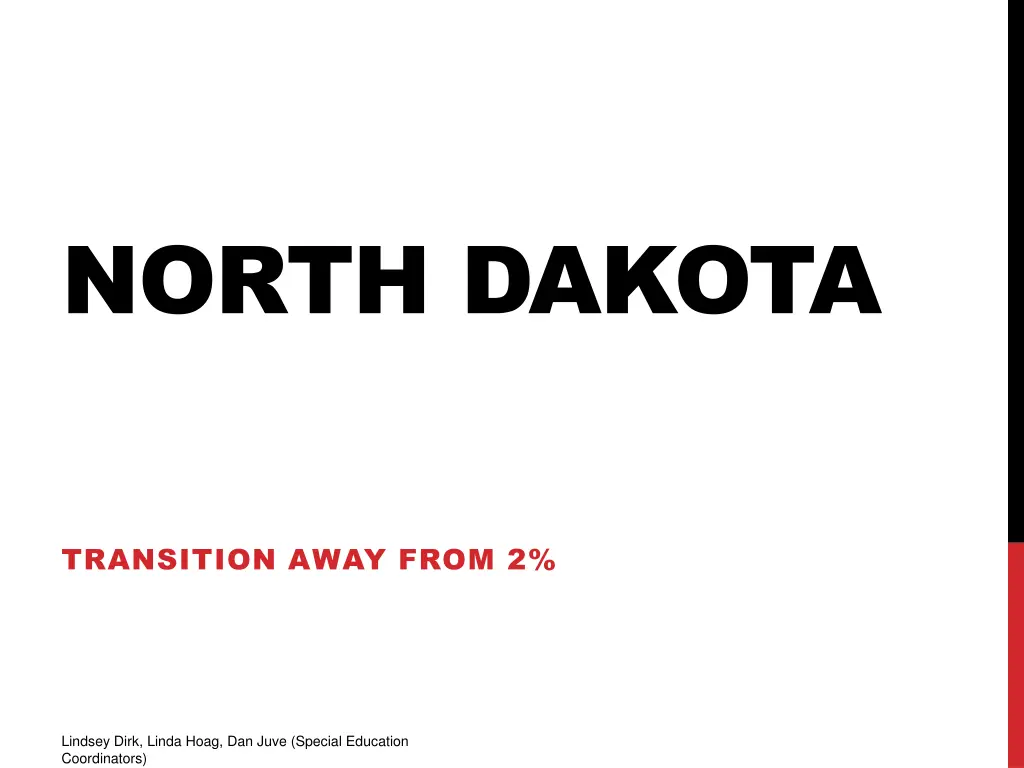
Improving Student Outcomes Through Education Initiatives
Explore action steps and strategies devised by special education coordinators in North Dakota to enhance student performance across various sub-groups. Initiatives include data disaggregation, Universal Design for Learning implementation, accommodations comparison, and standards-based IEP training. Discover the next steps towards developing a State Systemic Improvement Plan and utilizing Personal Development Grants for system enhancement.
Uploaded on | 1 Views
Download Presentation

Please find below an Image/Link to download the presentation.
The content on the website is provided AS IS for your information and personal use only. It may not be sold, licensed, or shared on other websites without obtaining consent from the author. If you encounter any issues during the download, it is possible that the publisher has removed the file from their server.
You are allowed to download the files provided on this website for personal or commercial use, subject to the condition that they are used lawfully. All files are the property of their respective owners.
The content on the website is provided AS IS for your information and personal use only. It may not be sold, licensed, or shared on other websites without obtaining consent from the author.
E N D
Presentation Transcript
NORTH DAKOTA TRANSITION AWAY FROM 2% Lindsey Dirk, Linda Hoag, Dan Juve (Special Education Coordinators)
USING DATA USING DATA ACTION STEPS: ACTION STEPS: 1. Disaggregation of data by the various sub-groups, i.e., ethnicity 2.SEA providing TA re: data analysis 3.Identify who are our persistently-low performing students (not just within SPED population) 4.Define our criteria (i.e., consistently low performance) for low-performing students (not just within SPED population) 5.Identify effective strategies and evidence-based practices that support student better outcomes
UNIVERSAL DESIGN UNIVERSAL DESIGN ACTION STEPS: ACTION STEPS: 1. PD in UDL for General Ed and Special Ed that includes examples of implementation 2. Teacher prep considerations; SEA explores the process that ESPB uses to evaluate the course syllabus regarding UDL training 3. Action research regarding learner characteristics matched to accommodations and performance on assessment 4. Define and Compare language (i.e., adaptations, accommodations, modifications to Universal tools, Accommodations, and designated supports ) 5. Identify and disseminate what accommodations the SEA is going to allow.
ACCOMMODATIONS ACCOMMODATIONS ACTION STEPS: ACTION STEPS: 1. Define and Compare language (i.e., adaptations, accommodations, modifications to Universal tools, Accommodations, and designated supports )
STANDARD STANDARD- -BASED IEPS BASED IEPS ? ACTION STEPS: 1. Training at the LEA level regarding Standards-based IEPs. 2. Technical Assistance and supervision/Monitoring of Standards- Based IEPs in LEAs by SEA 3. Identify strategies for collaboration between general ed and special ed at SEA and LEA levels (embedded at all levels)
NEXT STEPS: *State Systemic Improvement Plan is being developed to assist in improving student outcomes. *State Personal Development Grant: Working with multi-tier systems at the secondary level.
